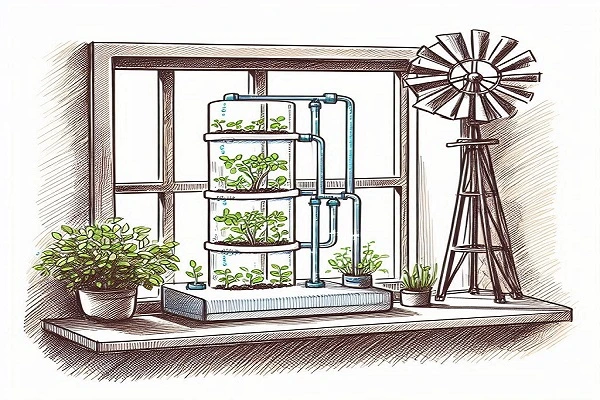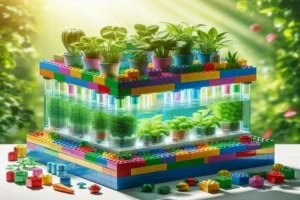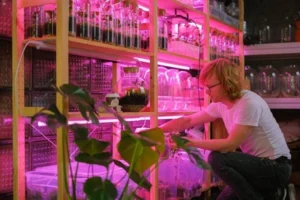Growing food at home is easier than ever—even in small apartments. Vertical hydroponics make the most of tight indoor spaces.
These systems use water, not soil, to grow herbs, greens, and more. They’re clean, compact, and surprisingly productive.
But it’s not just about stacking plants. To grow strong and fast, every part of the system needs to work together.
Two often-overlooked factors are oxygen and water flow. Without them, roots can’t breathe or absorb nutrients well.
Poor circulation leads to weak plants, root rot, and wasted effort. That’s why this topic matters so much.
In this post, you’ll learn why oxygenation and circulation are key to healthy growth in vertical DIY setups.
We’ll break down how to improve them, what tools help, and tips for making the most of your indoor garden system.
The Role of Oxygenation in Hydroponic Plant Health
In hydroponic systems, plants don’t grow in soil. Their roots are fully exposed to water and nutrients instead.
But water alone isn’t enough. Roots need oxygen, just like they do in soil. Without it, they struggle to function properly.
This is where dissolved oxygen, or DO, comes in. It’s the oxygen mixed into the water that roots use to “breathe.”
DO is crucial for root respiration. It helps roots break down food and absorb nutrients that fuel plant growth.
When DO levels drop, nutrient uptake slows down. Even if nutrients are present, the plant can’t make full use of them.
Low oxygen also weakens the plant’s natural defenses. This makes it more likely to develop root rot and other diseases.
Symptoms of low oxygen? Look for yellowing leaves, drooping stems, and slow or stunted growth.
You might also notice roots turning brown or mushy. Healthy roots should be white and firm.
Another sign is water that smells stale or sour. That usually means harmful bacteria are starting to grow.
Cooler water holds more oxygen. Aim for water temperatures between 65–70°F to keep DO levels steady.
Warmer water can be a problem. It reduces oxygen and encourages algae, which competes with your plants for resources.
For most small hydroponic systems, ideal DO levels range from 5 to 8 parts per million (ppm).
A simple tool called a DO meter can help you track those levels. It works kind of like a thermometer—but for oxygen.
You don’t need to check it constantly, but regular testing gives you peace of mind and helps catch issues early.
Maintaining good oxygen levels can be the difference between weak sprouts and thriving, full-grown plants.
It’s one of the most overlooked parts of a system—but one of the most important for healthy root development.
Understanding Water Circulation in Vertical Hydroponic Systems
In vertical hydroponics, water movement matters just as much as oxygen. Circulation is the engine behind the entire system.
It keeps nutrients flowing to every plant. It also helps deliver oxygen to roots, especially in stacked or tall designs.
Without proper flow, water gets stagnant. That can lead to poor nutrient distribution, root rot, and bacterial growth.
There are two main ways to move water: passive and active circulation. Most DIY systems use active methods with pumps.
- Passive systems rely on gravity and capillary action. They’re simple but not always ideal for vertical setups.
- Active systems use a pump to send water upward. Then gravity brings it back down, often through drip lines or tubes.
In a vertical system, water starts at the top and flows down through each plant level. Timing and speed are key.
Too fast, and roots can’t absorb enough. Too slow, and you risk dry spots or poor oxygen exchange.
Consistent circulation keeps nutrient levels balanced at every tier. It also prevents water from pooling in corners or pipes.
Pumps are the heart of the system. Choose one strong enough to move water to the top—without flooding the lower levels.
Use tubing that fits snugly and won’t kink. A blocked or bent hose can disrupt the entire flow path.
Timers help manage how long and how often water moves. This saves energy and prevents over-saturating the roots.
Even simple additions like mesh filters or inline strainers can keep the flow smooth and prevent clogging.
If your system sounds different or water stops trickling, check the pump, tubing, or any airlocks in the line.
Good circulation helps your plants grow evenly, stay hydrated, and get the nutrients they need—top to bottom.
Key Components for Oxygenation & Circulation
A solid hydroponic system depends on good tools. The right parts keep water moving and oxygen flowing where it’s needed.
Let’s start with air pumps. These devices push air into the water, helping boost dissolved oxygen for your plant roots.
Pair the pump with air stones. These break the air into tiny bubbles, which dissolve more easily into the water.
More bubbles = more oxygen. And the more oxygen your roots get, the healthier and faster your plants will grow.
Make sure your air pump is rated for the size of your system. Bigger setups need more airflow to stay balanced.
Now on to water pumps. These move water up through your vertical system, feeding each plant tier in a steady flow.
Pump power is measured in GPH—gallons per hour. Pick a pump that can lift water to your system’s top tier easily.
Too weak? Water won’t reach the upper levels. Too strong? You might flood the lower containers.
Use flexible tubing that matches the pump outlet size. Tight connections prevent leaks and pressure drops.
Flow control valves help adjust how much water moves through your system. Handy for testing and dialing in the perfect rate.
You’ll also want a timer to control pump cycles. This helps regulate when water moves and how often plants get fed.
Check valves are optional but useful. They stop water from flowing backward into the pump when it’s turned off.
Want extra protection? Add a mesh filter to catch debris before it clogs your tubing or air stones.
All these components work together. Good oxygen plus good flow = strong roots, healthy plants, and less chance of disease.
You don’t need fancy gear—just reliable parts that fit your space and setup goals.
DIY Tips for Enhancing Oxygenation & Circulation in Small Vertical Setups
Working with a small space? No problem. You can still build a system that breathes and flows like a pro.
Start by placing air stones low in your reservoir. The deeper they sit, the longer bubbles travel—and the more oxygen they release.
Use long, slim stones for tight containers. They spread bubbles better and fit into narrow tubs or vertical grow bins.
Go for a quiet air pump if your setup is near your bed or desk. Look for ones with rubber feet or low-vibration design.
For water movement, choose a compact submersible pump. These tuck neatly into small reservoirs and run quietly.
Use PVC pipes or stackable bins for vertical builds. Drill holes for net pots and let water trickle down from tier to tier.
Add a drip ring at the top to spread water evenly. It helps each plant get a fair share of nutrients.
Keep your tubing clean and short. Shorter hoses lose less pressure and are easier to manage in small setups.
Install a simple filter or wrap your pump with mesh to stop debris from clogging the system.
Tilt your containers slightly if water isn’t draining fast enough. A small angle can help improve flow.
Use a cycle timer to run your pump in intervals. This gives roots time to absorb water and air out between cycles.
Worried about algae? Cover your reservoir and tubing to block light. Algae compete for oxygen and clog your lines.
Clean your system regularly. Rinse stones, flush lines, and check for buildup every 1–2 weeks.
A little maintenance goes a long way. Cleaner parts = better flow = stronger plants.
Test, tweak, and adjust. That’s the beauty of DIY—you can customize every part of your system to fit your space.
Common Mistakes and How to Avoid Them
Even with a solid setup, small mistakes can cause big problems. Let’s go over what to avoid—and how to fix it fast.
Over-aerating your water? It happens. Too many bubbles can stir up debris and disturb roots in shallow reservoirs.
On the flip side, not enough oxygen leads to root rot. Check for weak airflow or clogged stones.
Using the wrong pump size is a common issue. Too strong floods the lower levels. Too weak starves the top.
Poor tubing layout can slow water flow. Avoid long, twisting paths that create pressure loss or airlocks.
Skipping filters or screens? That allows debris to clog your pump, drip lines, and air stones.
Neglecting maintenance is another big one. Biofilm, algae, and blockages build up fast in small systems.
Don’t ignore temperature. Warm water holds less oxygen and encourages bacteria. Keep it around 65–70°F.
Avoid open reservoirs near windows. Light invites algae, which eats up oxygen and competes with roots.
Check your gear regularly. A quiet pump might actually be broken. Look for slow flow or weird noises.
Lastly, don’t overcrowd your system. Too many plants can choke the roots and compete for limited resources.
Keep it simple. Fewer plants with proper care often grow better than an overpacked tower.
The Bottom Line
Good water flow and oxygen aren’t just technical details—they’re essential for healthy plants in hydroponic systems.
Even in small spaces, these two elements make a big impact. They help roots breathe, feed better, and fight off disease.
If your plants aren’t thriving, don’t just check the lights or nutrients—check the bubbles and the water flow too.
The best part? You don’t need fancy gear. A few smart tweaks can turn your setup from average to amazing.
Use what you’ve learned here to improve your vertical system, step by step.
Keep testing, adjusting, and staying curious. That’s how great DIY growers level up.
Your plants—and your plate—will thank you.




